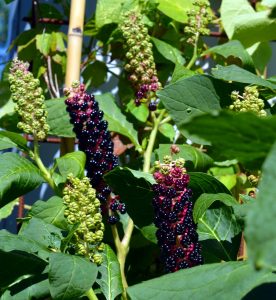Over the past year and a half, poison hemlock has been garnering a lot of attention from news outlets, blogs and newsletters as a poisonous plant for livestock (and humans).
If you are not familiar with poison hemlock, I suggest you get familiar with it so you can start to eradicate it from your farm or land.
But poison hemlock is not the only plant that you should be on the lookout for. There are other potentially poisonous or toxic plants to livestock you should recognize.
This article will focus on three toxic plants which livestock may encounter while grazing pastures in Ohio.
Jimsonweed (Datura stramonium)

Other common names include Jamestown weed, thorn apple, devil’s trumpet, mad apple and stinkweed.
Jimsonweed is toxic to all classes of livestock and humans, but most poisoning cases involve cattle. Poisoning by this plant is quite uncommon because it is unpalatable.
Poisoning cases usually occur in summer or autumn when little, if any, forage is available for consumption. All parts of the plant are poisonous, especially the seeds.
The symptoms of poisoning in livestock include: vomiting, dilated pupils, slowed respiration, intense thirst, frequent urination, convulsions, and death.
Jimsonweed is a large, summer annual growing three to five feet high with white or purplish funnel-shaped flowers. The stems are smooth and are either green or purple. The leaves are alternate, large, and the margins resemble oak leaf margins (coarsely and unevenly toothed).
The plant’s fruit is egg-shaped, green when immature and brown when mature, and covered with stiff prickles.
After the annual plant’s death, the leafless stem persists showing the distinctive spiny seed capsule.
Pokeweed (Phytolacca Americana)
Other common names include pokeberry, Virginia poke, inkberry and pigeonberry.
Pokeweed is toxic to all classes of livestock and humans. Cattle and occasionally horses are poisoned, but poisoning is quite rare.
Poisoning cases usually occur during hot, dry conditions when other forages become scarce or undesirable. Accidental poisoning can also occur when pokeweed is cut with corn silage.
All parts of this plant are poisonous, especially the roots. The symptoms of poisoning in livestock include severe diarrhea (often bloody and most common), vomiting, convulsions, and death (rare).
Pokeweed is a large branched herbaceous perennial that can reach heights of 10 feet. Pokeweed seeds can remain viable in the soil for up to 40 years.
Seedlings emerge from mid-spring to early summer, and shoots emerge from established roots in the spring.
Mature stems are smooth, branched, erect, and reddish in color. The grape-like clusters of dark purple berries are one of the most identifiable features.
The small berries are green when immature and turn to a dark purple at maturity with each fruit containing around 10 seeds.
Black Locust (Robinia pseudoacacia)
Other common names include false acacia and locust tree.
Black Locust is toxic to all classes of livestock. The leaves, especially wilted leaves, young shoots, pods, seeds and inner bark are toxic.
Most poisoning incidents involve horses chewing the bark of the tree. Cows, chickens, and sheep have also been reportedly poisoned.
Black locust poisoning is usually not fatal and symptoms include poor appetite, weakness, posterior paralysis, diarrhea, bloody feces, nervousness, and abnormal heartbeat.
Black Locust is a small, thorny, leguminous tree with dark-colored rough bark and long drooping white flower clusters.
Black locust can be easily identifiable by its alternate pinnately compound leaf with two sharp spines at the base of each leaf stalk. Each pinnately compound leaf has seven to 25 leaflets arranged with one leaflet at the tip and the rest in pairs.
The fruit is a flat brown, four-inch pod that contains kidney-shaped beans. Reproduction is either by seeds and/or shoots that sprout from roots of established plants.
Avoid poisoning livestock
Poisoning cases in livestock mostly occur when forage in the pasture is critically low and when cut for hay or silage.
The solution to controlling poisonings from these plants can be quite simple. Always have plenty of feed and forage available for livestock so they are not forced to consume less-desirable plants, and scout fields before making hay or silage.
If poisoning is suspected, you should call a veterinarian immediately, then scout the area for poisonous plants. If any poisonous plants are found, all livestock should be removed from the area.
Finally, eradicate poisonous plants by mowing or by applying the right herbicide based on the plant species. If using herbicides, be sure to follow the label and pay careful attention to the “Grazing Restrictions” section.
Identifying poisonous plants
The following websites will help you identify poisonous plants.
















You mentioned several parts of the black locust that are poisonous. But you didn’t say anything about the flowers. I have read that the flowers are not only edible, but some consider them to be the most delicious of all flowers. I’d like to hear your comment on this.